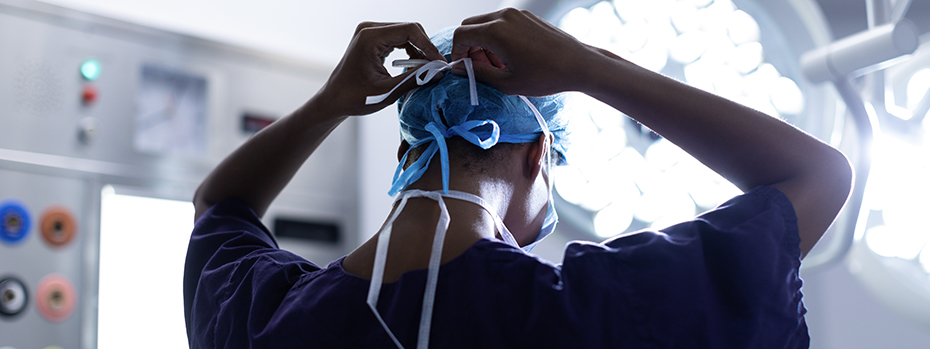Brachytherapy

Brachytherapy is a precise way to treat cancer using a source of radiation placed inside your body. At the OHSU Knight Cancer Institute, you’ll find:
- Expert radiation doctors on your cancer team.
- Advanced technology to deliver powerful treatment with fewer side effects.
- Treatment personalized to your anatomy and your tumor.
- A program that attracts patients from all over Oregon.
- The first center in the U.S. to use a hybrid Geneva applicator.
What is brachytherapy?
Brachytherapy (also known as internal radiation therapy) attacks cancer with powerful beams of energy. The energy comes from tiny radioactive seeds that are placed inside your body. This allows your doctors to deliver a higher dose of radiation directly to the tumor, reducing exposure to your healthy tissue.
Brachytherapy may be used as the primary treatment for some cancers. It might also be used along with other treatments, including external beam radiation therapy.
Treatment can be temporary, with your doctors removing the implants after a few minutes, hours or days. Or it can be permanent, with the material staying in place. This is safe because as time passes, the implants emit less and less radiation. Low-level radiation will not harm people around you.
Benefits of brachytherapy
- Brachytherapy delivers much stronger doses of radiation to the tumor, with less exposure to healthy organs.
- Studies show it can increase survival rates, especially when combined with other therapies.
Types of brachytherapy
- Intracavity: Doctors place the radioactive implants in a body cavity near the tumor. They might be inside the vagina, for example, to treat cervical or uterine cancer. Our experts use special applicators to place implants near the tumor. We often use this therapy for smaller tumors.
- Interstitial: Doctors use a special applicator to place the radioactive implants in the tumor itself. The applicator includes long, hollow needles to place the implants deep in the tumor. We often use this therapy for larger tumors.
- Hybrid: We have devices that are a combination of intracavity and interstitial. For example, we can place a device in a body cavity, and needles on the device can be inserted into the tumor. OHSU was the first center in the U.S. to use the hybrid Geneva applicator. We use it especially for cervical cancers.
- MRI-guided brachytherapy: OHSU is the only center in Oregon with brachytherapy guided by MRI (magnetic resonance imaging). This precise imaging helps doctors see the tumor's exact location. We use MRI both to plan and perform the procedure.
Y90 treatment (SIRT)
Y90 treatment (also known as selective internal radiation therapy or radioembolization) is a special type of brachytherapy to treat liver cancer. It is used for tumors that can’t be removed through surgery.
In Y90 treatment, doctors use a thin, flexible tube called a catheter to place tiny beads inside blood vessels in your liver. The beads contain the radioactive isotope Yttrium-90. The beads block the blood supply to the tumor and bombard it with radiation. The radiation only travels a short distance, reducing damage to the liver and other tissue.
How is brachytherapy delivered?
- High-dose rate (HDR): This treatment is temporary and given in repeat sessions. Because it uses powerful radiation, it usually takes less time than LDR brachytherapy. Your doctor may use thin flexible tubes called catheters to precisely place the implants. Or the implants can be placed with needles or a hybrid device. The implants are removed after a few minutes. You may have one or two HDR sessions in one day, or several in a week. This method is becoming the most common choice for many cancers.
- Low-dose rate (LDR): This treatment can be temporary or permanent. If temporary, it may take just a few minutes, or it can last several hours or days. You will stay in a room designed for the procedure. Your care team will limit exposure to others. If LDR treatment is permanent, the implants may be placed in your body during surgery. You may stay in the hospital overnight or for a few days to recover. The implants slowly release radiation over a few weeks or months. Eventually, almost all the radiation stops.
What cancers do we treat with brachytherapy?
What are the side effects of brachytherapy?
The most common side effects are tiredness, loss of appetite and skin reaction, like a sunburn. Learn more about what to expect in our Radiation Therapy FAQ.
Learn more
- Brachytherapy, National Cancer Institute
- Brachytherapy, RT Answers, American Society for Radiation Oncology
- Internal Radiation Therapy (Brachytherapy), American Cancer Society
For patients
Call 503-494-8756 to:
- Request an appointment
- Seek a second opinion
- Ask questions
Location
OHSU Knight Cancer Institute Radiation Medicine, Marquam Hill
Kohler Pavilion, fourth floor
808 S.W. Campus Drive
Portland, OR 97239
Free parking for patients and visitors
Refer a patient
- Refer your patient to OHSU.
- Call 503-494-4567 to seek provider-to-provider advice.
Read more
Learn more about OHSU Knight Cancer Institute treatments: